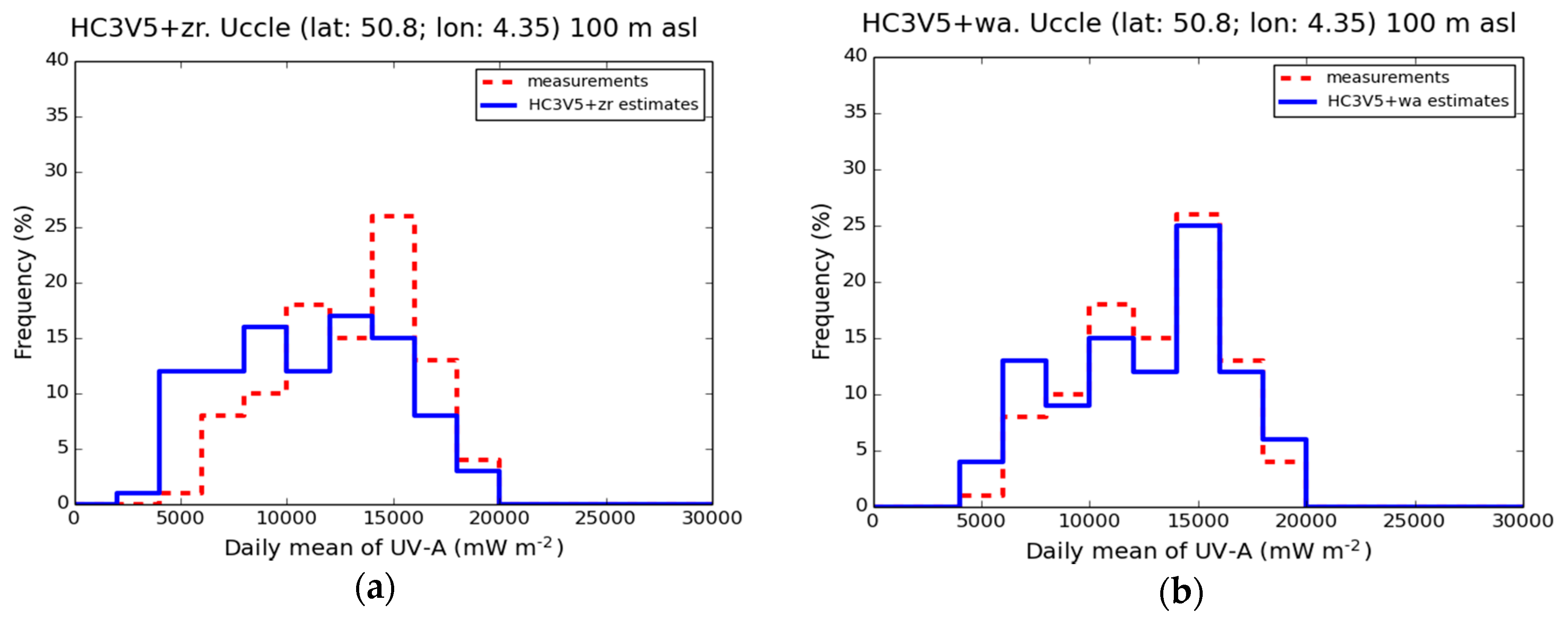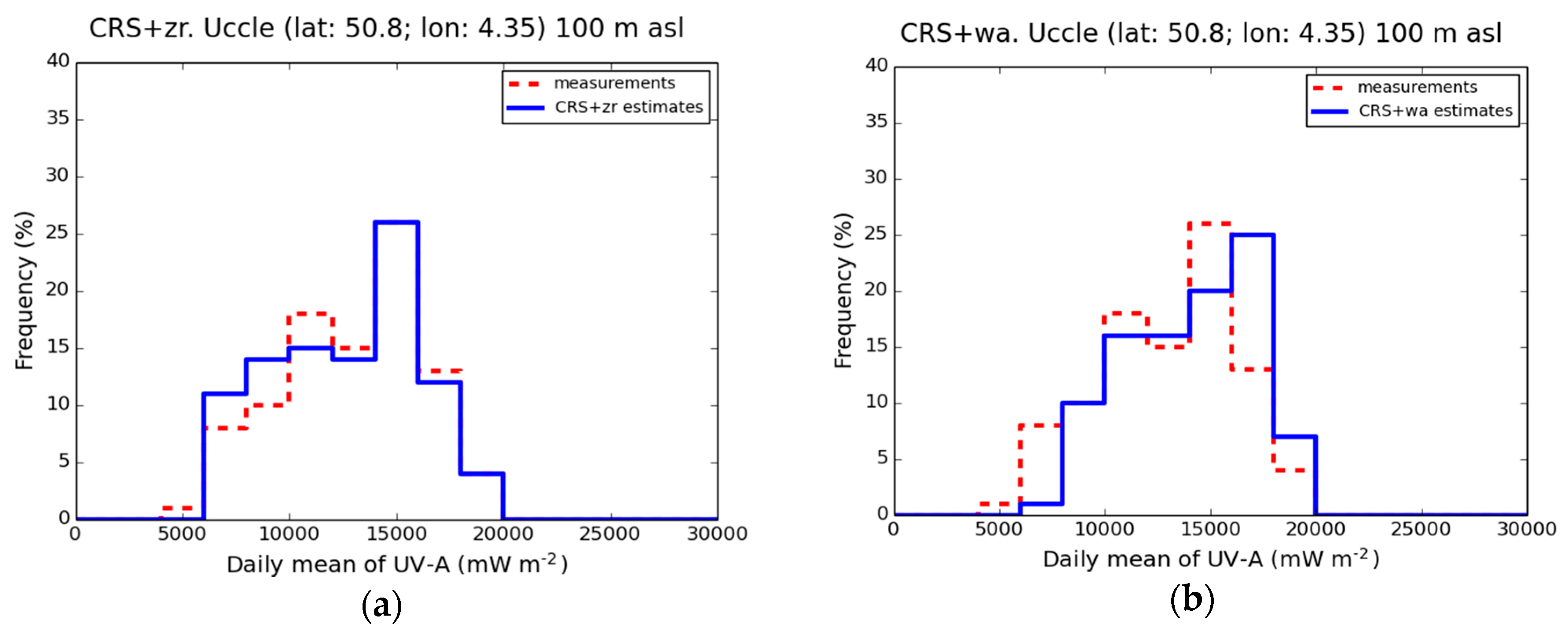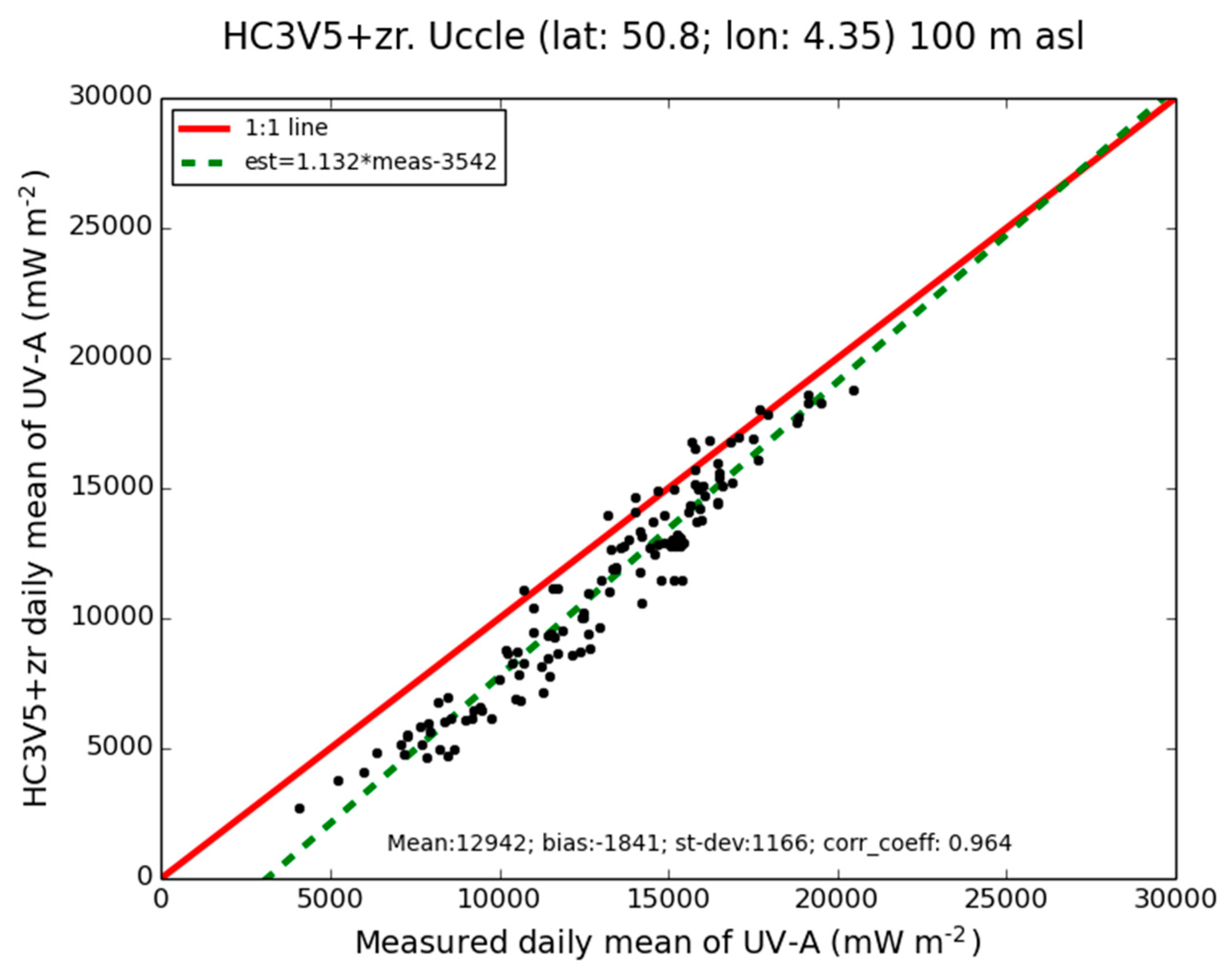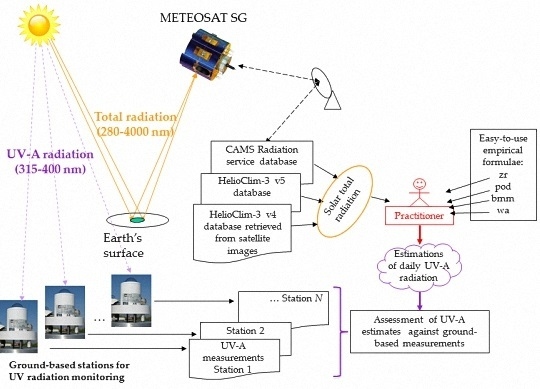To assess the validity and performances of the four previous “easy-to-use” formulae, they were applied to each total irradiance database for each station for estimating UV-A irradiances for each combination.
In
Figure 1a (“zr” formula and HC3v5), the distribution of
is biased towards low values. There are too many estimated values less than 10,000 mW·m
−2 and, on the contrary, not enough estimated values between 14,000 and 17,000 mW·m
−2. The frequency distribution of
produced by the “wa” formula is very close to that of
(
Figure 1b).
In the second example, the frequency distribution of
produced the “zr” formula in combination with CRS (
Figure 2a) is very close to that of
. The frequency distribution of
produced by the “wa” formula (
Figure 2b) is biased towards large values with a large positive bias. Values less than 8000 mW·m
−2 are not frequent enough and values greater than 16,000 mW·m
−2 are too frequent.
3.1. Deviations between and for Formulae in Combination with HC3v4
Table 4 reports the relative bias, standard deviation and RMSE for the four formulae combined with HC3v4.
The relative bias is a function of the formula and station. It is comprised between −25% to −2% for “zr”. The underestimation is larger for “pod” and the bias ranges between −29% to −46% of the mean
. The underestimation is even larger for “svc”, with a relative bias between −36% and −52%. The relative bias is much less for “wa”, where it ranges between −20% to 10% of the mean
. The relative bias of HC3v4 daily means of total irradiance
I when compared against measurements of the same quantity for July for the same years is −3% at Uccle and 0% at Kishinev [
37]. The underestimation of
I by HC3v4 at Uccle may partly explain the underestimation of
. However, it is small and the underestimation in
at Uccle (−17%, −40%, −45%, −7%) and Kishinev (−25%, −46%, −52%, −20%) cannot be explained by the bias in HC3v4 and should be mostly attributed to the formulae themselves.
For all formulae, one may observe a large scattering of the bias over the stations. There is no clear geographical tendency, except that Kishinev exhibits the largest relative bias in absolute value. Kishinev experiences more clear skies and is further south than the others with greater mean
(
Table 2). It could be expected that the formulae are less appropriate to this case. This may be true but one may observe that, as a whole, the stations exhibiting the largest underestimations are those exhibiting the largest standard deviations (
Table 2, stations Redu, Virton, Kishinev), i.e., the largest variability of the daily values
during the month of July.
This may be explained by the fact that changes in some atmospheric constituents may affect
and not
I, and accordingly that are not present in
, or reciprocally, that affect
I and, hence,
and do not affect
. For example, Figure 4 in [
49] exhibits examples of the dependence of the ratio of UV total (280–400 nm) to total irradiance as a function of water vapor column content or aerosol load. It has also been observed that the cloud effect on UV radiation is less than the cloud effect on total irradiance and may even be an enhancing effect [
50].
The relative standard deviation of the deviations
ranges from 9% to 16% for “zr”, 8% to 14% for “pod”, 10% to 15% for “bmm” and 8% to 15% for “wa”. There is no formula surpassing the others regarding the standard deviation. The latter depends upon the station and is nearly constant, whatever the formula for a given station. The relative standard deviation of deviations of HC3v4 total irradiance
I against measurements is 7% at Uccle and 6% at Kishinev [
37]. The errors made by HC3v4 in estimating
I may partly explain the standard deviation of
. Additional explanations may lie in changes in some atmospheric constituents, as discussed before.
The relative RMSE varies greatly with the formula and the station. Due to their large negative biases, the formulae “pod” and “bmm” exhibit relative RMSE between 31% and 51% which are large for estimates of daily means. Better, but still large, relative RMSE are attained with formula “zr”—between 11% and 27%—and the best ones are reached by “wa” as a whole, with a range between 10% and 22%.
Though Kishinev offers the greatest relative bias and RMSE in absolute value, they are not so different from other stations for several formulae—see e.g., the bias and RMSE for Redu, for three formulae in
Table 4. Moreover, the standard deviation in Kishinev is similar to or less than that in the other stations whatever the formula. It can be concluded that the formulae in combination with HC3v4 are as much appropriate to Kishinev as to the other stations.
3.2. Deviations between and for Formulae in Combination with HC3v5
Similarly to
Table 4,
Table 5 reports the relative bias, standard deviation, and RMSE for the four formulae combined with HC3v5. The results are very close to those for HC3v4. The discussion and conclusions are similar and are not repeated here.
The bias is most often negative: the four formulae underestimate
with a magnitude that depends on the station. The UV irradiances by formulae “pod” and “bmm” are underestimated by approximately 40% of the mean
. The bias is less for “zr” with a range comprised between −27% and 1%, and “wa”, where it ranges from −22% to 11% of
. The relative bias of HC3v5 total irradiance
I against measurements is −1% at Uccle and −2% at Kishinev [
37]. The underestimation of
I by HC3v5 may partly explain the underestimation of
. However, it is small and the underestimation at Uccle (−14%, −38%, −44%, −5%) and Kishinev (−27%, −47%, −53%, −22%) cannot be explained by the bias in HC3v5 and should be mostly attributed to the formulae themselves.
The relative standard deviation of the deviations
ranges from 9% to 15% for “zr”, 8% to 14% for “pod”, 9% to 16% for “bmm”, and 8% to 15% for “wa”. The relative standard deviation of deviations of HC3v5 total irradiance
I against measurements is 7% at Uccle and 6% at Kishinev, like for HC3v4 [
37]. The errors made by HC3v5 in estimating
I may partly explain the standard deviation of
.
The relative RMSE varies greatly with the formula and the station. Due to their large negative biases, the formulae “pod” and “bmm” exhibit relative RMSE between 29% and 54% which are large for estimates of daily means. Better relative RMSE are attained with formula “zr”—between 12% and 28%—and the best ones are reached by “wa” as a whole, with a range between 9 and 23%.
Like for HC3v4, it is also concluded that the formulae in combination with HC3v5 are as much appropriate to Kishinev as to the other stations.
3.3. Deviations between and for Formulae in Combination with CRS
Table 6 reports the relative bias, standard deviation and RMSE for the four formulae combined with CRS. The results for the bias are quite different from the previous ones. The bias is always negative for the formulae “pod” and “bmm”, with a large relative underestimation ranging, respectively, between −13% and −45%, and −22% and −51% depending on the station. The bias is partly negative, partly positive for the two other formulae. It ranges from −24% up to 21% of the mean
for “zr”, and from −19% to 30% for “wa”. Compared to the combinations with HC3v4 or HC3v5, the relative bias is much more variable with the station for a given formula.
The relative bias of CRS total irradiance
I against measurements is 12% at Uccle and 1% at Kishinev [
37]. The bias at Kishinev is very small as for HC3v4 or HC3v5. The underestimation by the formulae at Kishinev (−24%, −45%, −51%, −19%) cannot be explained by this bias and should be mostly attributed to the formulae themselves. At Uccle, the relative bias for each formula is less in absolute value than for HC3v4 or HC3v5, and is more satisfactory for users, though it is due to the overestimation of
I by CRS. However, the underestimation of
by the formulae remains.
The relative standard deviation of the deviations
ranges from 8% to 17% for “zr”, 9% to 18% for “pod”, 10% to 19% for “bmm” and 8% to 17% for “wa”. It is fairly constant with formulae for a given station. The relative standard deviation of deviations of CRS against measurements of
I [
37] is 12% at Uccle and 7% at Kishinev. The errors made by CRS in estimating
I may partly explain the standard deviation of
.
The relative RMSE varies greatly with the formula and the station. Because of their large negative biases, the formulae “pod” and “bmm” exhibit relative RMSE between 19% and 52% which are large for estimates of daily means. Better relative RMSE are attained with formula “wa” with a range between 14% and 33%, and the best ones are reached by “zr” as a whole, with a range between 12% and 25%.
Like for HC3v4 and HC3v5, it is also concluded that the formulae in combination with CRS are as much appropriate to Kishinev as to the other stations.
3.4. Reconstruction of the Day-to-Day Variability
The Pearson correlation coefficient between the actual measurements
and the estimated irradiances
was computed for each case (
Table 7). Formulae “zr” and “pod” exhibit the same correlation coefficients because they are affine functions of
and the correlation coefficient is insensitive to offset and slope.
The correlation coefficients are high; they are quite often greater than 0.9, meaning that most of the variability in is captured in . For the same station and same database of total irradiance, the correlation coefficient is fairly constant, i.e., it does not depend on the formula. It is concluded that the formulae are equivalent in this aspect, i.e., all are able to reproduce most of the variability contained in .
For given formula and database, i.e., along a column, the correlation coefficient varies as a function of the station. No clear explanation was found for such changes. One reason may be due to site-specific changes in atmospheric constituents that affect and not I and, accordingly, that are not present in , or reciprocally, that affect I and, hence, , and do not affect as already discussed above.
For a given formula, HC3v4 and HC3v5 exhibit similar correlation coefficients. This is not surprising since both databases use the same cloud properties and that in mid-latitude Europe, clouds play a major role in changes in UV-A irradiance. We may conclude that the fact that HC3v5 calls partly upon a different clear-sky model, McClear, plays a minor role. For a given formula, the correlation coefficient for CRS is less than those for the HC3 databases, except for Kishinev. Since very high correlation coefficients were found for the McClear model when comparing estimates of the total solar irradiance
I to measurements [
33,
51,
52], and because the effects of clear atmosphere and clouds may be decoupled [
35], the main cause lies likely in the determination of the cloud properties in CRS.
High correlation coefficients justify the fit of affine functions between
and
.
Figure 3 and
Figure 4 exhibit examples of scatterplots between
and
for, respectively, “zr” and “wa” formulae combined with HC3v5 for Uccle, along with the fitting lines. Ideally, the slope of the fitted line should be equal to 1 and the offset equal to 0. A slope of 1 means that the day-to-day variability of
is well reproduced by
with the same intensity. In the “zr” example, the slope of the fitted line is 1.13, i.e., slightly greater than 1, which means that the slope (0.054) of the formula “zr” (Equation (2)) is slightly too large for this case. In the “wa” example, the slope is 1.08 and is closer to 1.
The following
Table 8,
Table 9,
Table 10 and
Table 11 report the coefficients of the fitted affine functions obtained by a least-square fit and their uncertainties (95% confidence) for each possible combination. Actually, none of the formulae exhibit offsets close to 0. The offset may be large and the uncertainty may be even greater. In the minimization process, the offset is the coefficient which concentrates most of the errors. This lack of accuracy in the estimation of the offset may not be important in studies where correlation and reproduction of intensity of day-to-day variability are the most important factors. The offset is not discussed any further.
The slope is fairly close to 1 and ranges between 0.81 and 1.12 for the formula “zr” combined with HC3v4 (
Table 8). When combined with HC3v5, the slope is most often a bit greater than that for HC3v4. It ranges between 0.86 and 1.16. It may be concluded that, as a whole, in combination with the HelioClim-3 databases, the “zr” formula which has been established for Bratislava is suited to mid-latitude Europe as far as daily variability of
is concerned.
The slope ranges between 0.65 and 0.90 for the formula “zr” combined with CRS. This is clearly below 1. The intensity of the daily variation of will be lessened in . A slight increase of the factor 0.054 in Equation (2) by, say, 10% will result in a better reconstruction of the intensity by this combination, at the likely expense of increased bias, standard deviation, and RMSE.
The slope ranges between 0.59 and 0.81 for the formula “pod” combined with HC3v4 (
Table 9). When combined with HC3v5, the slope ranges between 0.62 and 0.84 and is slightly greater than that for HC3v4. When combined with CRS, the slope ranges between 0.47 and 0.65 and is much less than that observed for HC3v4 or HC3v5. The slope is very far from 1, whatever the case, and the intensity of the daily variation of
will be dampened in
by a factor of approximately 0.7 when in combination with HelioClim-3 and 0.6 with CRS.
The formula “pod”, developed for Lodz, has a form similar to “zr” but with a lower factor (0.039 instead of 0.054) and a lower additive constant. Hence, it is unsurprising to observe in
Table 9 that the slopes of the fitting line are less than those for the “zr” formula.
The slope ranges between 0.50 and 0.70 for the formula “bmm” combined with HC3v4 (
Table 10). When combined with HC3v5, the slope ranges between 0.53 and 0.72 and is slightly greater than that for HC3v4. When combined with CRS, the slope ranges between 0.40 and 0.59 and is much less than that observed for HC3v4 or HC3v5. The slope is very far from 1 whatever the case and the intensity of the daily variation of
will be dampened in
by a factor of approximately 0.6 when in combination with HelioClim-3 and 0.5 with CRS.
The slope for the formula “bmm” is too small, whatever the database. This indicates that further improvements in this formula may be attained if the exponent of I is set to 1, thus getting closer to the affine form of the formulae “zr” and “pod”. The bias would likely be reduced and the standard deviation would likely increase.
The slope ranges between 0.75 and 1.06 for the formula “wa” combined with HC3v4 (
Table 11). When combined with HC3v5, the slope ranges between 0.83 and 1.09. The slopes for the combination of “wa” and HC3v4 or HC3v5 are close to 1.0 ± 0.2 except for Kishinev in the case of HC3v4. It may be concluded that, as a whole, in combination with the HelioClim-3 databases, the “wa” formula which has not been established for a specific area is suited to mid-latitude Europe as far as daily variability of
is concerned.
When “wa” is combined with CRS, the slope ranges between 0.59 and 0.82 and is much less than that observed for HC3v4 or HC3v5. The slope is very far from 1 and the intensity of the daily variation of will be dampened in by a factor of approximately 0.7–0.8.











